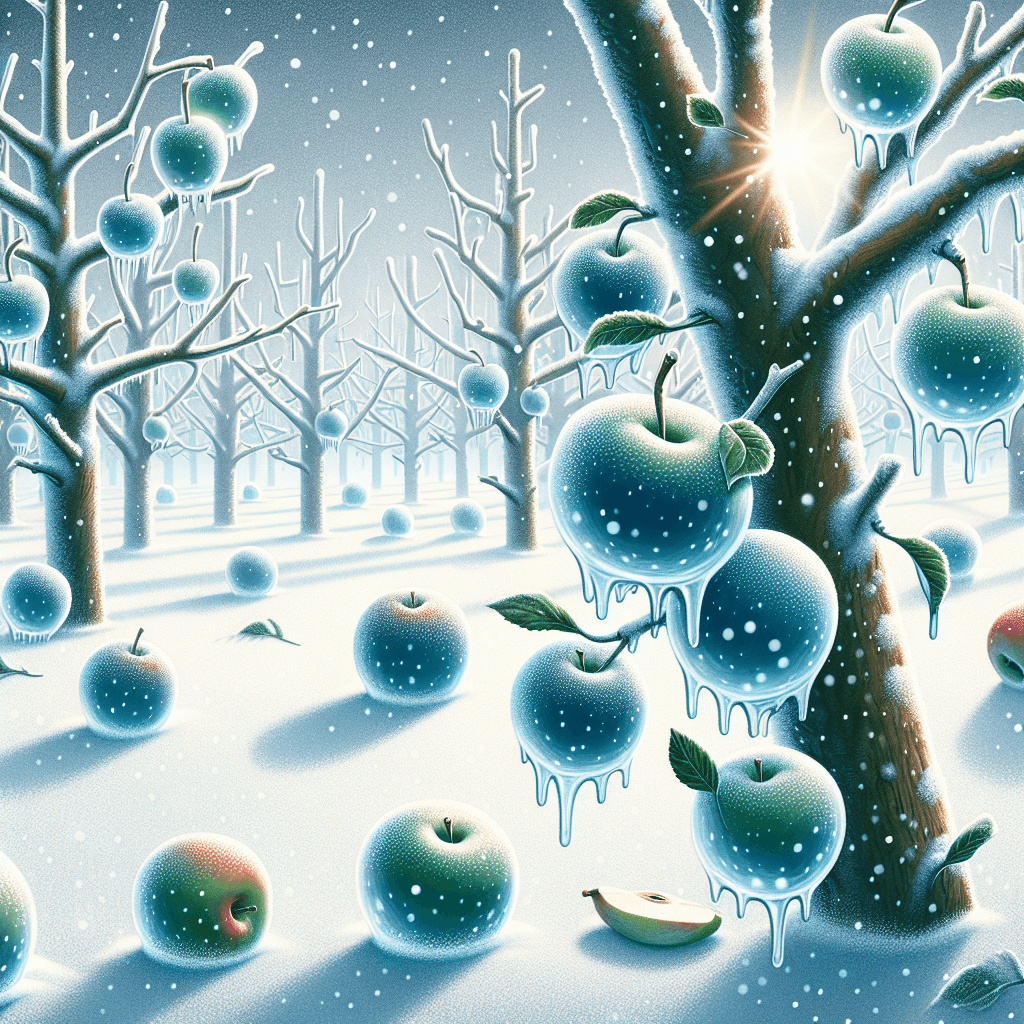The Crystal Case of the Missing Fruit: Why Do Some Apples Vanish After Freezing, Leaving Only Their Perfect Ice Shells
Ever heard of 'ghost apples'? This bizarre and beautiful phenomenon occurs when apples seemingly disappear from their icy cocoons, leaving behind a perfect, hollow ice shell in the shape of the fruit.


Too Long; Didn't Read
Under specific freezing rain conditions, an apple rots and turns to mush inside its frozen coating. The mushy apple then slides out, leaving a perfectly-formed hollow ice shell known as a 'ghost apple'.
The Crystal Case of the Missing Fruit: Why Do Some Apples Vanish After Freezing, Leaving Only Their Perfect Ice Shells?
Have you ever heard of "ghost apples"? It sounds like something out of a fairy tale, but under very specific weather conditions, a truly bizarre and beautiful phenomenon can occur: apples seemingly disappear from their icy cocoons, leaving behind a perfect, hollow ice shell in the shape of the fruit. This isn't magic, but a fascinating display of physics at work. This post delves into the science behind why some apples vanish after freezing, leaving only these delicate ice sculptures.
The Birth of a "Ghost Apple"
The term "ghost apple" or "ice apple" refers to the delicate, hollow sphere of ice left behind when the actual apple inside decomposes and disappears, often after a period of freezing rain followed by prolonged cold. Imagine walking through an orchard after a deep freeze and seeing these ethereal, translucent apple shapes still clinging to branches, shimmering in the winter light. It’s a rare sight, but one that perfectly illustrates an intriguing natural process. The core of this mystery lies in the interplay between freezing temperatures, the composition of apples, and a scientific process called sublimation.
The Science Behind the Vanishing Act
To understand how an apple can vanish from within its icy tomb, we need to look at a few key scientific principles.
The Initial Freeze and Ice Encasement
The journey to a ghost apple typically begins with freezing rain or sleet.
- Coating of Ice: As freezing rain falls, it coats everything it touches—including apples still on the tree—with a layer of ice. This forms a perfect, solid mold around the fruit.
- Apple Freezes Solid: Simultaneously, the apple itself, which is about 85% water, also freezes solid due to the sub-zero temperatures.
At this point, you have a frozen apple encased in an additional layer of ice.
The Role of Decomposition and Apple Structure
An interesting observation, noted by individuals like farm market gardener Andrew Siemonsma in Michigan who witnessed this phenomenon, is that "ghost apples" often form from apples that were already beginning to rot or were overripe before the freeze.
- Weakened Structure: Rotting apples have a mushier consistency because their cellular structure is breaking down. This makes them less dense than a firm, healthy apple.
- Higher Water Mobility: The water within this mushy, decomposing pulp is less tightly bound.
The Magic of Sublimation
This is where the "vanishing" happens. Sublimation is the process where a solid (like ice) turns directly into a gas (water vapor) without first melting into a liquid.
- Conditions for Sublimation: Sublimation occurs more readily under specific conditions:
- Low Temperatures: Continued cold below freezing point.
- Low Humidity: Dry air allows more water vapor to be absorbed.
- Airflow: Gentle breezes can carry away water vapor, encouraging more sublimation.
Once the apple is frozen and encased in ice, if these conditions persist, the frozen apple pulp inside the ice shell begins to sublimate. The mushier, less dense, frozen pulp of a rotting or very ripe apple sublimates more easily or at a faster rate than the clear, solid ice shell that formed around it from the freezing rain.
Why the Shell Remains (Temporarily)
The ice shell formed by the freezing rain is often clearer and more structurally sound than the frozen apple pulp, especially if the pulp was already decomposing.
- The water molecules in the apple's pulp slowly turn into vapor and escape, possibly through tiny cracks or imperfections in the ice shell, or even directly through the ice itself, albeit very slowly.
- Because the apple pulp was mushy and less dense, it effectively "shrinks" and disappears as its water content sublimates, leaving the more resilient outer ice shell intact. Eventually, the ice shell itself will also melt or sublimate, but for a period, it stands as a hollow testament to the apple that was once there.
Not All Apples Become Ghosts
This phenomenon is not common. It requires a very specific sequence of weather events:
- Apples (often overripe or slightly rotted) are still on the tree.
- An episode of freezing rain coats the apples in a layer of ice.
- A period of prolonged, very cold, and dry weather follows, allowing the apple pulp to sublimate before the outer ice shell melts.
The type of apple, its stage of ripeness, and the exact weather conditions all play a crucial role, making ghost apples a rare and captivating spectacle.
Conclusion: Nature's Icy Illusion
The mystery of why some apples vanish after freezing, leaving only their perfect ice shells, is a beautiful example of natural processes working in concert. It’s a delicate dance between freezing, the apple's composition (especially if compromised by rot), and the remarkable process of sublimation. These "ghost apples" remind us that even in the harshest conditions, nature can create moments of delicate, ephemeral beauty. So, the next time you hear of an ice storm followed by a deep freeze, keep an eye out – you might just witness this fascinating disappearing act for yourself, a true testament to the quiet wonders of the physical world.


